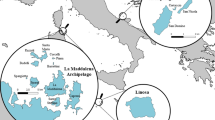Summary
A breeding experiment was performed to examine the hypothesis that zebra finches (Taeniopygia guttata) preferentially mate with full sibs. Each bird had the opportunity to mate with one of 2 sibs or 28 nonsibs. Preferential mating between relatives did not occur. Offspring of sib pairs developed more slowly and sib pairs experienced more reproductive loss through death of offspring.
Similar content being viewed by others
References
Ågren G (1984) Incest avoidance and bonding between siblings in gerbils. Behav Ecol Sociobiol 14:161–169
Bateson P (1978) Sexual imprinting and optimal outbreeding. Nature 273:659–660
Bateson P (1980) Optimal outbreeding and the development of sexual preferences in Japanese quail. Z Tierpsychol 53:231–244
Bengtsson BO (1978) Avoiding inbreeding: At what cost? J Theor Biol 73:439–444
Boag PT, van Noordwijk AJ (1987) Quantitative genetics. In: Cooke F, Buckley PA (eds) Avian genetics: a population and ecological approach. Academic Press, London, pp 45–78
Böhner J (1983) Song learning in the zebra finch (Taeniopygia guttata): Selectivity in the choice of a tutor and accuracy of song copies. Anim Behav 31:231–237
Burley N (1977) Parental investment, mate choice, and mate quality. Proc Natl Acad Sci USA 74:3476–3479
Burley N (1980) Clutch overlap and clutch size: alternative and complementary reproductive tactics. Am Natur 115:223–246
Burley N (1986) Sexual selection for aesthetic traits in species with biparental care. Am Natur 127:515–545
Burley N (1988) The differential allocation hypothesis: an experimental test. Am Natur 132:611–628
Burley N, Bartels PJ (1990) Phenotypic similarities of sibling zebra finches. Anim Behav 39:174–180
Burley N, Zann RA, Tidemann SC, Male EB (1989) Sex ratios of zebra finches. Emu 89:83–92
Burley N, Minor C, Strachan C (1990) Social preferences of zebra finches for siblings, cousins and non-kin. Anim Behav 39:775–784
Eales LA (1985) Song learning in zebra finches: some effects of song model availability on what is learnt and when. Anim Behav 33:1293–1300
Falconer DS (1981) Introduction to quantitative genetics, 2nd edn. Longman, New York
Ghent AW (1978) Computational shortcuts for the hypergeometric distribution: the appropriate generator where territoriality is suspected. Biologist 60:113–122
Goodwin D (1982) Estrildid finches of the world. Comstock, Ithaca, NY
Immelmann K (1962) Beiträge zu einer vergleichenden Biologie australischer Prachtfinken (Spermestidae). Zool Jb (Syst) 90:1–196
Immelmann K (1965) Australian finches in bush and aviary. Halstead, Sydney
Immelmann K (1969) Song development in the zebra finch and other estrildid finches. In: Hinde RA (ed) Bird vocalizations: their relation to current problems in biology and psychology. Cambridge University Press, Cambridge, pp 61–77
Immelmann K, Kalberlah HH, Rausch P, Stahnke A (1978) Sexuelle Prägung als möglicher Faktor innerartlicher Isolation beim Zebrafinken. J Ornithol 119:197–212
Lerner IM (1954) Genetic homeostasis. Oliver and Boyd, Edinburgh
Miller DB (1979a) Long-term recognition of father's song by female zebra finches. Nature 280:389–391
Miller DB (1979b) The acoustic basis of mate recognition by female zebra finches (Taeniopygia guttata). Anim Behav 27:376–380
Peck JR, Feldman MW (1988) Kin selection and the evolution of monogamy. Science 240:1672–1674
Price MV, Waser NM (1979) Pollen dispersal and optimal outcrossing in Delphinium nelsoni. Nature 277:294–297
Shields WM (1982) Philopatry, inbreeding, and the evolution of sex. Albany: State University of New York Press
Slater PJB, Clements FA (1981) Incestuous mating in zebra finches. Z Tierpsychol 57:201–208
Sokal RR, Rohlf FJ (1981) Biometry. 2nd edn. Freeman, San Francisco
Thiessen DD, Gregg B (1980) Human assortative mating and genetic equilibrium: and evolutionary perspective. Ethol Sociobiol 1:111–140
van Noordwijk AJ (1987) Quantitative ecological genetics of great tits. In: Cooke F, Buckley PA (eds) Avian genetics: a population and ecological approach. Academic Press, London, pp 363–380
Wright S (1977) Evolution and the genetics of populations, vol 3. Experimental results and evolutionary deductions. University of Chicago Press, Chicago
Zar JH (1974) Biostatistical analysis. Prentice Hall, Englewood Cliffs, NJ
Author information
Authors and Affiliations
Additional information
Offprint requests to: N. Tyler Burley
Rights and permissions
About this article
Cite this article
Fetherston, I.A., Burley, N.T. Do zebra finches prefer to mate with close relatives?. Behav Ecol Sociobiol 27, 411–414 (1990). https://doi.org/10.1007/BF00164067
Received:
Accepted:
Issue Date:
DOI: https://doi.org/10.1007/BF00164067




